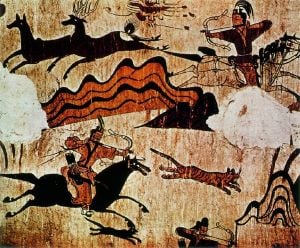Complex of Goguryeo Tombs
| Complex of Goguryeo Tombs | ||||||||
|---|---|---|---|---|---|---|---|---|
|
| Complex of Koguryo Tombs* | |
|---|---|
| UNESCO World Heritage Site | |

| |
| State Party | |
| Type | Cultural |
| Criteria | i, ii, iii, iv |
| Reference | 1091 |
| Region** | Asia-Pacific |
| Inscription history | |
| Inscription | 2004 (28th Session) |
| * Name as inscribed on World Heritage List. ** Region as classified by UNESCO. | |
The Complex of Goguryeo Tombs lies in North Korea. In July 2004 it became the first UNESCO World Heritage site in the country. The site consists of 63 individual tombs from the later Goguryeo kingdom, one of Three Kingdoms of Korea, located in the cities of P'yŏngyang and Namp'o. Goguryeo was one of the strongest kingdoms in the north east of China and the Korean Peninsula between the 5th and 7th centuries AD. The kingdom was founded in the present day area of Northern Korea, Northeastern China, and part of Manchuria around 32 BC, and the capital was transferred to P'yŏngyang in AD 427.
Many of the tombs, such as the Anak Tomb No. 3, have beautiful wall paintings. The tombs are almost all that remains from this culture. There are over 10,000 Goguryeo tombs overall, but only about 90 of those unearthed in China and Korea so far have wall paintings. The Complex of Goguryeo Tombs inscribed on the World Heritage List contains the majority of these tombs with wall paintings. It is thought that the complex was used as a burial site for kings, queens and other members of the royal family. The paintings found on the tombs offer a unique insight into the everyday life of the Goguryeo period.
The murals are strongly coloured and show daily life and Korean mythologies of the time. By 2005, 70 murals had been found, mostly in the Taedong river basin near Pyongyang, the Anak area in South Hwanghae province, and in Ji'an in China's Jilin province.
The following criteria were considered by UNESCO to merit the Goguryeo tombs' inscription as a World Heritage site:
- The wall paintings are masterpieces of the Goguryeo period. The tombs themselves reflect ingenious engineering capabilities.
- The customs of the Goguryeo culture were influential all over East Asia, including Japan.
- The site offers exceptional insights into the Goguryeo culture, both into everyday life and burial customs.
- The Goguryeo tombs are an important example of this burial typology.
In May 2006, 2,360 individual tombs were discovered at the site of the ancient Goguryeo kingdom during work on the Yunfeng Reservoir. Ruins of an ancient city were discovered as well. Among the ruins was a city wall that was 1.5 meters tall and four meters wide. Evidence also suggested the presence of a moat. A dozen tombs were found within the city.
See also
- Korean art
- Korean painting
- History of Korea
- List of Korea-related topics
- Capital Cities and Tombs of the Ancient Koguryo Kingdom
External links
- Complex of Koguryo Tombs, UNESCO World Heritage
- Northeast Asia's intra-mural mural wars, 6th century Korean murals
Template:Archaeology-stub
Coordinates:
Credits
New World Encyclopedia writers and editors rewrote and completed the Wikipedia article in accordance with New World Encyclopedia standards. This article abides by terms of the Creative Commons CC-by-sa 3.0 License (CC-by-sa), which may be used and disseminated with proper attribution. Credit is due under the terms of this license that can reference both the New World Encyclopedia contributors and the selfless volunteer contributors of the Wikimedia Foundation. To cite this article click here for a list of acceptable citing formats.The history of earlier contributions by wikipedians is accessible to researchers here:
The history of this article since it was imported to New World Encyclopedia:
Note: Some restrictions may apply to use of individual images which are separately licensed.